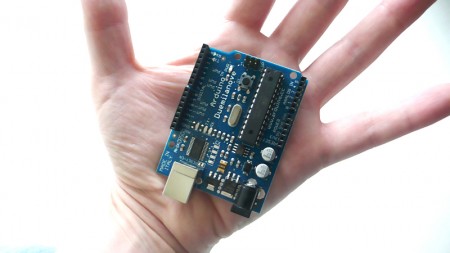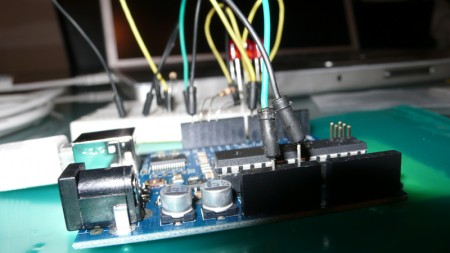If you are one of those people that read Make or frequent Instructables, this is semi-old news. But for everyone else, this is a godsend. When I say everyone else, I mean creatives who want to use microcontrollers to up their game. Say hello to Arduino, MTFY’s new best friend.
The Arduino is an open source microcontroller board. What is that you ask? Basically, it is the heart of any technical product you can think of (e.g. evil robot, solar light box, or bluetooth motion sensored video mp3 player ). You don’t have to deal with messy soder, or go to engineering school to build these projects anymore. And there are plenty of websites that share any code or tutorials that you might need during your project. There is one catch though- you have to share all your secrets back to the community. That is the open-source part. The article Build It. Share It. Profit. Can Open Source Hardware Work? on wired.com explains:
Arduino’s business model: The team has created a company based on giving everything away. On its Web site, it posts all its trade secrets for anyone to take-all the schematics, design files, and software for the Arduino board. Download them and you can manufacture an Arduino yourself; there are no patents. You can send the plans off to a Chinese factory, mass-produce the circuit boards, and sell them yourself – pocketing the profit without paying Banzi a penny in royalties. He won’t sue you. Actually, he’s sort of hoping you’ll do it. That’s because the Arduino board is a piece of open source hardware, free for anyone to use, modify, or sell.
You can read a more detailed review of the company in that article. I am writing this article to show what we were able to create with an Arduino on our first try. The Hello World for Arduino is called Blink. It tells a single LED to blink on and off; and it does what is says. We took it a step further:
1.Use a push button to turn the project on
2.Blink 3 LEDs in sequential order
3.Turn off those LEDs in order when the button is depressed.
First we ordered a basic Arduino Duemilanove Starter Kit. Before we got the kit, we did some basic research on circuits, resistors, and breadboards on the various arduino sites (google it).
After receiving the package, we methodically separated all the parts into their appropriate container- kidding. We scattered everything on the table, and began putting the wires, LEDs, and button on the breadboard and Arduino.
We used a video on Make to get a basic idea of what to do- Watch Here.
Then we downloaded the Arduino software at ardunio.cc. The software put many examples in the applications folder, but Blink is the one we opened. Next we just edited a little code (we know Java), and then sent it to to the board through the USB. Finally, we danced the victory dance.
Here are some pics.
Heidi and I do have an advanced knowledge of circuits and coding already, so that obviously was a little help ;-). But, you can see how easy this really was. And if you are good at copying and pasting, then coding should be pretty easy with all the free stuff out there on the interwebs.
Lastly, we purchased Making Things Talk, by Tom Igoe. This is essential to helping anyone who is interested in creating objects that communicate with one another (e.g. bluetooth, ethernet, radio, wifi).
We have a few products in the works right now based on the Arduino board. We will keep everyone posted on the details.
TAKE AWAY
We have been messing with the Arduino for about a week now, and find it very easy to work with. There are alot of creative projects already online for us to pull ideas from. The communities for this are huge. And, people are actually profiting from this. Open-source does work for things other then software; and the guys at Arduino are proving that.









WHAT TO DO NOW?